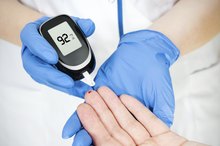Can Infection Raise Blood Sugar Levels in Nondiabetics?
Even if you do not have diabetes, you can experience drops and spikes in blood sugar levels for many reasons. If your blood sugar level gets too high or too low, you might develop many symptoms and/or health problems. Stress, poor diet, illness and infections can all cause your blood sugar level to change, and if you notice the warning signs, it is important to talk to your physician about the best treatment approach.
Blood Sugar
After a meal, your body breaks food down into glucose either for immediate use, or else it's stored for later use. The hormone insulin, as well as other chemicals, regulate how much glucose is in your system. If the level of glucose in your bloodstream gets too high, many complications can result. A general goal for everyone is to keep your blood sugar levels no higher than 100 mg/dL, says MedlinePlus 1. A blood sugar level higher than this can indicate not just diabetes, but also some forms of cancer, Cushing syndrome, an imbalance of various hormones, thyroid disorders or it might be the body's reaction to stress, trauma or an infection.
- After a meal, your body breaks food down into glucose either for immediate use, or else it's stored for later use.
- The hormone insulin, as well as other chemicals, regulate how much glucose is in your system.
Infections and Blood Glucose Levels
Blood Sugar Imbalance Symptoms
Learn More
When your body is under mental or physical stress, such as when fighting off an infection, hormones such as cortisol are released to help your body cope. The hormones that are released to fight off the infection might have the side effect of raising your blood sugar levels, so your body has the energy it needs to get better. This effect can happen to both diabetics and nondiabetics.
Symptoms
If you have an infection and are concerned about your blood sugar levels, it is important to know the warning signs of nondiabetic hyperglycemia, which are the same symptoms that occur in diabetics: hunger, sweating, shakiness, dizziness, lightheadedness, thirst, sleepiness, confusion, difficulty speaking, anxiety and weakness. If you notice the signs of high blood sugar, your physician can run tests to identify what type of infection is present and what the best treatment approach is.
Treatment
What Is Considered a High Blood Sugar Level for a Diabetic?
Learn More
A high blood sugar level caused by an illness or infection can occur within hours or days after the infection settles into the body. It is important to seek medical attention early on because high blood sugar levels that are left untreated can lead to difficulty breathing, dizziness when you stand up, rapid weight loss, increased drowsiness or confusion. In severe cases, you can become unconscious or go into a coma. As soon as you notice the warning signs, contact your doctor so that your blood sugar levels and the infection can be brought under control to avoid complications.
- A high blood sugar level caused by an illness or infection can occur within hours or days after the infection settles into the body.
- It is important to seek medical attention early on because high blood sugar levels that are left untreated can lead to difficulty breathing, dizziness when you stand up, rapid weight loss, increased drowsiness or confusion.
Related Articles
References
- MedlinePlus: Glucose Test –- Blood
- American Diabetes Association. 5. Lifestyle management: Standards of medical care in diabetes-2019. Diabetes Care. 2019;42(Suppl 1):S46-60. doi:10.2337/dc19-S005
- National Institute of Diabetes and Digestive and Kidney Diseases. Diabetes diet, eating, & physical activity. Published December 2016.
- American Diabetes Association. The big picture: Checking your blood glucose.
- American Diabetes Association. 6. Glycemic Targets: Standards of Medical Care in Diabetes-2020. Diabetes Care. 2020;43(Suppl 1):S66-S76. doi:10.2337/dc20-S006
- American Diabetes Association. 14. Management of diabetes in pregnancy: Standards of medical care in diabetes-2020. Diabetes Care. 2020;43(Suppl 1):S183-S192. doi:10.2337/dc20-S014
- Porcellati F, Lucidi P, Bolli GB, Fanelli CG. Thirty years of research on the dawn phenomenon: Lessons to optimize blood glucose control in diabetes. Diabetes Care. 2013;36(12):3860-2. doi:10.2337/dc13-2088
- American Diabetes Association. 5. Lifestyle management: Standards of medical care in diabetes-2019. Diabetes Care. 2019;42(Suppl 1):S46-60. doi:10.2337/dc19-S005
- Colberg SR, Sigal RJ, Yardley JE, et al. Physical activity/exercise and diabetes: A position statement of the American diabetes association. Diabetes Care. 2016;39(11):2065-2079. doi:10.2337/dc16-1728
- American Diabetes Association (ADA). Understanding A1C.
- Garber AJ, Abrahamson MJ, Barzilay JI, et al. Consensus statement by the American association of clinical endocrinologists and American college of endocrinology on the comprehensive type 2 diabetes management algorithm - 2019 executive summary. Endocr Pract. 2019;25(1):69-100. doi:10.4158/CS-2018-0535
Writer Bio
I hold a Master's degree in exercise physiology/health promotion. I am a certified fitness specialist through the American College of Spots Medicine and an IYT certified yoga teacher. I have over 25 years experience teaching classes to both general public and those with chronic illness. The above allows me to write directly to the reader based on personal experiences.









